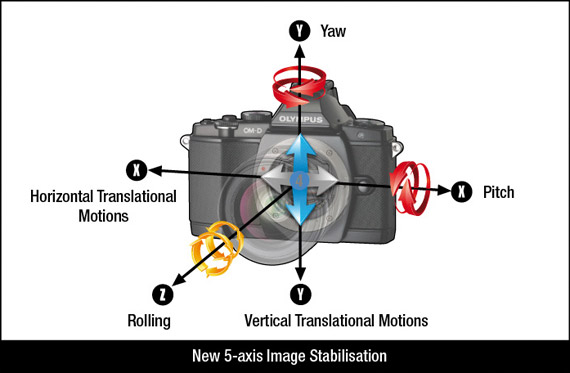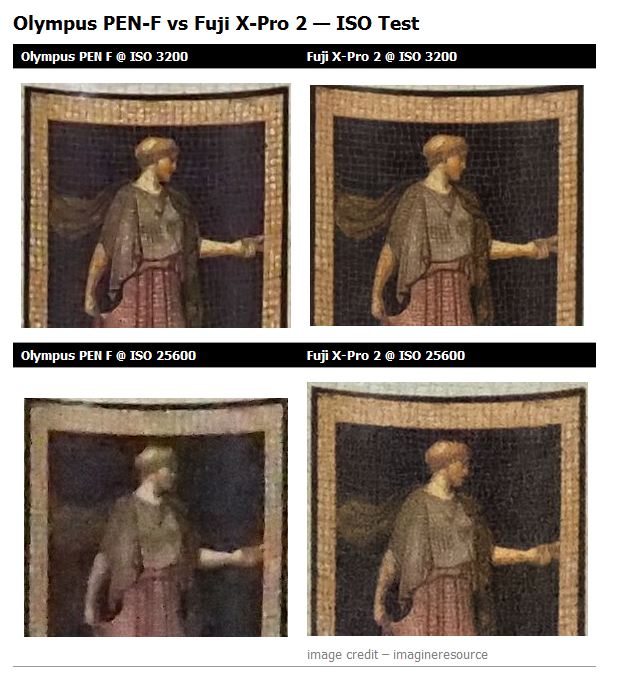 Both the camera look solid and stylish, the Fuji X-Pro two is bit bigger in size compared to the Olympus PEN F. The X-Pro 2 uses third genration of X-Trans sensor on the other side we have Olympus PEN F that uses new but traditional CMOS sensor.
Both the camera look solid and stylish, the Fuji X-Pro two is bit bigger in size compared to the Olympus PEN F. The X-Pro 2 uses third genration of X-Trans sensor on the other side we have Olympus PEN F that uses new but traditional CMOS sensor.
| Features/ Models | Olympus PEN-F |
Fuji X-Pro 2 |
| Sensor | 20.3MP Live MOS Sensor | 24.3MP APS-C X-Trans CMOS III Sensor |
| Sensor size | Micro Four Thirds System | APS-C (1.5x Crop Factor) |
| Sensor Type | Contrast Detect | Contrast + Phase Detect |
| Image Stabilization | 5-Axis In-Body Image Stabilization | No |
| Low pass filter | No | No |
| Image processor | TruePic VII Image Processor | X-Processor Pro Engine |
| AF system | 81 contrast based AF points |
273-Point AF with 77 Phase-Detect Points |
| ISO | 50-25600 | 100-51200 |
| Shutter Min/ mix | 30-1/8000 | 30-1/32000 |
| Continuous shooting speed | 10 fps | 8 fps |
| Video | Full HD 1080p Video Recording at 60 fps | Full HD 1080p/60 Video |
| Display | 3.0″ 1.037m-Dot Vari-Angle Touchscreen | 3.0″ 1.62m-Dot LCD Monitor |
| Viewfinder | EVF | Advanced Hybrid Multi Viewfinder |
| Hot shoe | Yes | Yes |
| Wireless | Built-In | Built-In |
| Environmentally sealed | Yes | Yes |
| Battery life | 330 | 350 |
| Dimensions | 147 x 115 x 81 mm | 149 x 112 x 78 mm |
| Weight | 860 g | 495 g |
From the specification comparison table we can see that
The Fuji X-Pro 2 camera features more bigger sensor and bit extra resolution over the Olympus PEN F, the other advantage of the X-Pro 2 camera is X-Trans architecture based sensor that completely eliminates the need Low pass filter.
 As you can see in the sensor size difference, the Olympus PEN F features 4/3 sensor on the other side the Fuji X-Pro 2 camera features APS-C sensor, so without doubt we will see more details in Fuji X-Pro 2 images.
As you can see in the sensor size difference, the Olympus PEN F features 4/3 sensor on the other side the Fuji X-Pro 2 camera features APS-C sensor, so without doubt we will see more details in Fuji X-Pro 2 images.
 The 5 axis image stabilization system used in Olympus reduces the camera shake upto 5 stops, the camera doesn’t need IS based lenses and on the other side we have Fuji that doesn’t feature built in IS, the IS depend upon the type of lenses used.
The 5 axis image stabilization system used in Olympus reduces the camera shake upto 5 stops, the camera doesn’t need IS based lenses and on the other side we have Fuji that doesn’t feature built in IS, the IS depend upon the type of lenses used.
The AF system of Fuji is advance compared to the Olympus, due to the help of X-Trans tech the Fuji enjoys the Hybrid CMOS AF and lock down AF in a min speed of 0.06 sec only, on the other side we have PEN -F that limited to contrast based AF system only.
Video recording is almost same, both the camera limited to full HD video recording and doesn’t support 4K. It’s really strange to ss a $1K range mirrorless cameras announced in 2016 and remains limited to Full HD mode only.
Olympus PEN-F vs Fuji X-Pro 2 — ISO Test

Olympus PEN-F vs Fuji X-Pro 2 Image Analysis
In the High ISO test we can clearly see that the Fuji is showing more details compared to the Olympus PEN-F camera.
AT ISO 3200 Olympus PEM -F fails to pick the minor details of the image and the Low-Pass filter less Fuji showing intense amount of details with excellent color and contrast output.
At ISO 25600 Fuji showing excellent color, contrast and details compared to Olympus PEN-F camera.
Verdict
Based on specification comparison of both the camera and high ISO test results we highly recommend you to get Fuji X-pro 2 camera if you care about the image quality and AF system.
Do share your thoughts with us.







“the other advantage of the X-Pro 2 camera is X-Trans architecture based sensor that completely eliminates the need Low pass filter.” … But the Pen-F also does not have a low pass filter… so is this still an advantage for Xpro2? Am I missing something? Also I can’t imagine that the Pen is 860g almost twice as heavy as the Xpro2… that weight must be wrong in the comparison chart…
the weight of Pen F is quoted with lens; the Xpro2 without lens!
Pen F without lens is 420 grams.
Honestly, I’ve processed both files and I found the pens images easier to work with and had better detail in lower iso’s. There’s grain but attractive grain there in the higher ISO’s. Fuji xtran iii is an improvement but not quite there yet.